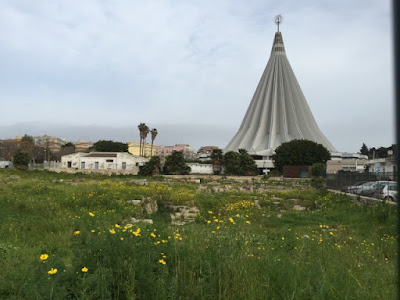Today was archaeology day for us in Siracusa, including visits to the museum and the archaeological park.
 |
| Greek ruins surround the Sanctuario |
Despite having been on our feet much of the day yesterday (my iPhones says we walked more than 7 miles) we were awake early -- for no particular reason other than the habits of old age.
 |
| The "Concrete Monster" can be seen for miles around |
The hotel provided a very nice breakfast, and we filled up for the day. We then set off for the museum, which is a bit of a hike from this hotel. Along the way we stopped briefly at Sanctuario Madonna delle Lacrime (Shrine of Our Lady of Tears).
 |
| Greek ruins were incorporated into the Crypt |
This modernist church was designed in 1957. Work began in 1966 and was slowed by the discovery of Greek ruins under the site (some of which are outside, and some are in the crypt). It has been criticized as "The Concrete Monster of Siracusa," but we stepped in, between Sunday Masses, and thought it a pretty neat worship space.
 |
| The main worship space is quite impressive |
The "Museo Archeologico Regionale Paolo Orsi" is almost directly across the street from the church. It, too, is a very modernist design, looking like three triangles within a larger triangle, if seen from above. The area around Siracusa has a rich ancient past, and this place is filled with an overwhelming number of fascinating artifacts, from the Stone Age through the Byzantine period.
 |
| Roman goddesses for votive offerings -- lots of them! |
Quite by accident, we discovered that the first Sunday of the month is a free day at Siracuse museums. So while we paid a small "stupid tourist tax" yesterday by taking an unnecessary bus trip, we more than made up for it today with free tickets.
 |
| An ancient artist in Syrakuse made a copy of this even more ancient bust. It's huge, nearly 3 feet tall. |
Siracusa (Syrakuse in Greek) was a very important Greek colony and trading port. The Romans conquered it militarily, but culturally the Greeks conquered the Romans. The Romans appropriated the Greek religion, Greek pottery, Greek foods, Greek theater, Greek sculpture -- you name it. Even the common language spoken across the Roman Empire was a dialect of Greek.
 |
| The Roman amphitheater |
There is pottery here as fine as anything you'll find in the National Museum of Athens, and sculptures that could be in the Vatican Museum in Rome.
 |
| The Greek theater |
The "Tecnoparo di Archimede" is about a 10 minute walk from the museum. Here, among other ruins, one can see a Roman mini-colosseum, built for the same sorts of gladiator games played in Rome. But there is also a huge Greek theater -- the largest in the region -- that could seat 16,000. It is remakably well preserved.
 |
| View from the cheap seats at the top |
Nearby are also the remains of the quarry used by both Greeks and Romans for the stone needed to build the ancient city. A large part of the quarry later became the necropolis (literally, "city of the dead," or city cemetery) where quite a few of the artifacts in the museum were recovered.
 |
| The Ear of Dionysius -- a cave in the old quarry |
We walked a very long ways to another museum -- art this time -- having been told that it would be open and free today, too. However, something had been lost in translation, and the place was locked up tight. We consoled ourselves by stopping for some excellent gelato (Italian ice cream).
After the long walk back to the hotel, further consolation came in the form of a large bottle of cold German beer which we enjoyed on the deck of our room while resting and reading. More reading and people-watching on the promenade beside the harbor refreshed us enough to walk back to Ortegia for a fine seafood dinner.












No comments:
Post a Comment